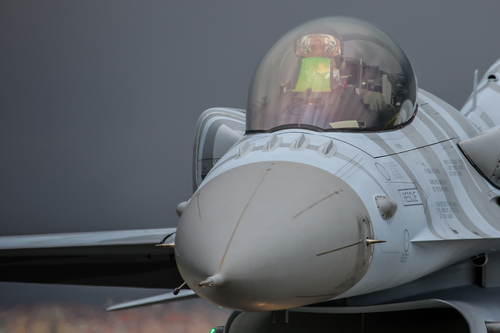
In an unprecedented display at Edwards Air Force Base, the skies bore witness to a groundbreaking dogfight between a human-piloted F-16 and its AI-controlled counterpart, a scenario reminiscent of science fiction yet firmly grounded in today’s technological advancements.

This remarkable event marks a pivotal moment in military aviation, showcasing an AI’s ability to maneuver at speeds exceeding 550 miles per hour, withstanding forces five times that of gravity, and going head-to-head with human skill.

The contest, shrouded in secrecy, demonstrated an AI’s potential not only to outmaneuver its human adversaries but also to make critical decisions, such as weapon deployment in combat—a concept both intriguing and unsettling.

According to Frank Kendall, United States Secretary of the Air Force, “It’s a security risk not to have it. At this point, we have to have it.” His confidence in AI’s role in future air combat is unwavering, even as he insists on human oversight when it comes to using weapons.

As the world pivots to digital warfare, the evolution of air combat training has become essential.

For modern pilots, the journey begins with the low-tech T-6 Texan II, where aviators hone their skills before advancing to jets like the Northrop T-38 Talon, equipped with the latest avionics and targeting systems.

The training is rigorous, reflecting the complexity of operating multi-million-dollar fighter machines such as the F-35 Lightning II and the F/A-18 Super Hornet, and culminates with real-world practice that simulators simply cannot replicate.

Artificial intelligence in military aviation is not merely an upgrade; it represents one of the most significant advances since stealth technology emerged in the 1990s.

With the current trajectory of global military development, particularly the rise of China’s air force, the U.S. is accelerating the integration of AI-enabled unmanned warplanes.

These autonomous agents are not only proving their worth in dogfights but are also learning from each engagement. The future envisions swarms of unmanned aircraft, designed to overwhelm enemy defenses and protect human pilots from high-risk scenarios.

However, the technological leap to AI dominance in the skies is not without its critics. There are valid concerns about the ethical implications of autonomous weapons and their potential to make life-and-death decisions without human intervention.

The International Committee of the Red Cross has cautioned against this, calling for an urgent international political response.

Yet, these AI jets are rapidly advancing. “We have to keep running. And we have to run fast,” Kendall stated, highlighting the urgency in maintaining technological superiority.

While the introduction of AI-controlled fighter jets heralds a new chapter in military strategy, the essence of pilot training remains timeless. Even as the U.S. Air Force eyes a fleet of over 1,000 unmanned planes operational by 2028, the foundational skills of air combat remain crucial.

In a world where human pilots might soon find themselves a rarity in the cockpit, their knowledge, experience, and adaptability will continue to play a significant role in shaping the future of aerial warfare—a future where artificial intelligence might not only augment but potentially redefine the very nature of air combat.
